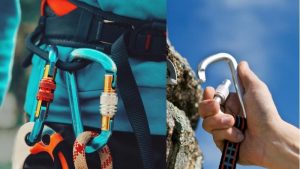When most people wonder, “What is a carabiner?”, they think of the small, metal clips used by rock climbers to attach ropes and other gear to their bodies and the cliff face. However, carabiners come in various types, shapes, and sizes, each with their specific purpose.
The myriad types of carabiners on the market today are enough to overwhelm you and make picking your target or required carabiner a bit difficult. However, a dive into the crowd of carabiners will let you know each type’s purpose, use, and specialty. Thus, exploring the variations, styles, and designs is crucial whether you are an aspirant or pro climber.
Technology and the popularity of climbing as a sport have caused the proliferation of sub-types, variations, and clearly distinguishable versions. That phenomenon has made an in-depth analysis of the gear under discussion necessary. Let’s start by defining the gear and the causes of such varieties of a single gear.
What Is a Carabiner?
A carabiner is a metal ring with a spring-loaded gate used to connect ropes, chains, straps, or other pieces of equipment. Usually made from aluminum, stainless steel, or titanium and are either oval or D-shaped, carabiners come in various sizes and strengths, depending on the intended use.
Climbers most commonly use them to connect their harness to the rope while ascending it, besides being used as a quick-release mechanism for safety belts or other pieces of equipment. Other popular carabiner uses include attaching gear to backpacks, securing tents to poles, and suspending food from trees while camping.
You may wonder and should know about the causes of the myriads of versions and variations of this climbing gear to reach the best carabiner for you.
Causes of Varieties Types of Carabiners
Multiple applications and purposes have prompted variations in styles and designs of the carabiner, and the result is a wide variety of the same on the market. There are general-use carabiners and climbing carabiners, and we will confine our focus on the types of carabiners for climbing.
The foremost reason for the variety of carabiners is that different climbers have different preferences while climbing. Some people prefer smaller carabiners, while others need larger ones. Some people prefer plain carabiners, while others seek those with more features. And finally, some people prefer to buy from a certain brand or company and petzl carabiner is one of the most preferred by climbers.
The bottom line is that there is a wide range of carabiners available because climbers and other outdoor enthusiasts have a wide range of needs and preferences.
The climbing Call team has conducted thorough research on the variations, versions, and sophistication of this item since its advent in the field. And the result is the following climbing carabiners briefed precisely to offer you the clear impression of every type, its uses, and benefits.
Types of Carabiners & Their Uses
We can take three common or popular carabiners as seed carabiners: the locking carabiner, nonlocking, carabiner, and HMS Carabiners. A clear knowledge of these three main types will help us get going.
Locking Carabiner
A locking carabiner has a mechanism to prevent it from opening accidentally. This is important for climbing, as a carabiner that opens unexpectedly could cause a climber to fall. There are two types of locking carabiners: manual and automatic.
A manual locking carabiner requires the user to activate the locking mechanism, while an automatic locking carabiner will lock automatically when the gate is closed. These two locking carabiners and their variations and versions will have due coverage in the relevant sections ahead.
Not to bypass, locking carabiners are available in both standard and oval shapes. The standard shape is more common and has a round cross-section. The oval carabiner is less common, but some climbers prefer it because it has a larger surface area and is less likely to twist shut than the standard shape.
Non-locking Carabiner
Non-locking carabiners are essential for attaching gear to a harness or pack, connecting two ropes, or rigging up a hanging rappel. They are not that expensive and lighter than locking carabiners, but they are also less safe because they can open accidentally.
On a serious note, this carabiner is never to be used as a belay device or for any other purpose where safety is critical. They are also used in emergencies, such as a nonlocking carabiner to hang a person from a helicopter quickly.
HMS Carabiner
The HMS carabiner is a versatile tool to use in a variety of ways. It has a locking mechanism perfect for use as a keychain, and the small size means it can be easily carried around. The lightweight design makes it easy to swing from a rope or other equipment.
The carabiner works efficiently as a connector for ropes or chains, making it an ideal choice for outdoor activities such as climbing or camping. Used for multiple purposes, you can hang a pen or pencil, and it can also be used as a bottle opener. In fact, the carabiner’s popularity lies in its versatile attachments to other objects such as keys, bags, and clothing.
Different Variations of Carabiners
Sophistication in technology and innovative ideas have prompted variations in the carabiners’ uses, style, and design. As a result, we come across several other versions of the seed carabiners. Specifically, locking carabiners have experienced most of the variations and creative applications as people widely use it because it is the safest and most efficient of all. All the other variations or versions fall to the two sub-categories of locking carabiners:
- Manual Locking Carabiner
- Automatic Locking Carabiner
Manual Locking Carabiner
Manual locking carabiners have a small lever on the side that must be lifted in order to open the carabiner. This type is typically less expensive than the auto-locking variety and highly popular for a wide range of activities, such as climbing, rappelling, and rescue operations.
The hexagonal shape is the most common carabiner shape, and it comes in a variety of sizes. It is also the most versatile, as it is highly useful for a huge range of activities.
This locking carabiner attaches things to each other, such as a climber’s harness to a rope or rappelling down a cliff.
Screw Gate Carabiner
A screw gate carabiner features a mechanism on the gate that screws shut to keep it closed. This carabiner is typically used for rappelling, as it is less likely to open accidentally than other types of carabiners. Screw gate carabiners are also preferred as belay devices for the said reason.
The Kwik-Lok carabiner is a widely used screw gate carabiner with a locking mechanism on the gate that uses a key to lock and unlock the carabiner. The locking mechanism is designed such that a user can attach the carabiner to an object and then lock it.
In contrast, other types of carabiners require that the locking mechanism be closed before attaching the carabiner.
Straight Gate Carabiner
A straight gate carabiner with its straight or slightly curved opening works magic for rappelling and belaying. This gate opening design is easier to open than a curved or bent gate.
It is best when joined by a carabiner with a gate opening that is approximately one-fourth of the carabiner’s size.
This allows the carabiner to open without snagging on the rope. It also allows for a quick gate opening to pass through it. In fine, straight gate carabiners (also known as straight gate locking carabiners) are designed to open and close more easily than a bent gate or curved gate carabiner.
Bent Gate Carabiner
A bent gate carabiner has a specially shaped gate that allows the rope to be easily inserted into the carabiner. The bent or curved gate allows the rope to slip into the carabiner easily. If necessary, the bent gate carabiner makes it easier for a climber to pull the rope through the carabiner.
They are popular for rappelling, as they quickly and securely attach the rope to the carabiner. Bent gate carabiners are also popular for belaying, as they can help keep the belay device in place when clipping into the carabiner.
Slide Gate Carabiner
The slide gate carabiner is a newer design that is gaining popularity. A slide gate carabiner has a slider mechanism on the gate that allows the carabiner to be opened with one hand. This type of carabiner is often used to connect belay devices to ropes and attach harnesses to anchors.
You may have both locking and nonlocking versions made from either aluminum or stainless steel. It functions like a standard carabiner, but the gate is on a track that allows it to slide freely open and close.
This makes it easier to clip and unclip from gear, ropes, and other carabiners. The slide gate carabiner also tends to be more secure than a standard carabiner because the gate can’t be accidentally open if it’s bumped or jostled.
Wire Gate Carabiner
A wire gate carabiner is a type of carabiner with a wire gate instead of a traditional solid metal gate. For many years, the wire gate carabiner has been a staple in the climbing community.
They are lightweight and easy to use, perfect for any climber, beginner, or expert. There are many different types of wire gate carabiners on the market, so it is important to research before purchasing one.
An important feature to look for when purchasing a wire gate carabiner is the gate’s strength. The wire gate carabiner should be made from aircraft-grade aluminum or stainless steel.
Automatic Locking Carabiner
Designed with a spring-loaded gate to lock the carabiner automatically, this locking carabiner is a preference for connecting trad gear to each other, such as a belay device to a rope. Featured with the spring-loaded mechanism in the gate, auto-locking carabiner closes when not being manually pushed open.
Some automatic mechanisms only lock at release, while others lock automatically upon use. Some have a ‘bottom-loading’ gate, fixed in position; this allows the user to open the gate with one hand more easily.
However, this type of top-loading carabiner can be harder to operate with gloves. Now, go for variations and styles in auto-locking climbing carabiners.
Twist-lock Carabiner
Twist-lock carabiners are the most common type and are easy to use – you just twist the barrel at the top to open and close it. They’re also the cheapest types of carabiners. However, they can be a little tricky to use with gloves on, and they can be opened accidentally if they get hit or if something gets caught in them. The gates, also fixed in position, do not open up to the full extent.
Twist-lock carabiners are ideal for activities such as caving and spelunking, where there is always a risk of something falling on the carabiner and opening it up.
Slider Carabiner
Slider carabiners are a type of climbing gear designed to make clipping and unclipping the rope much easier while climbing a rope using ascenders. A large center hole allows you to grip the rope easily, and they also have a small hole at one end that can be used to clip the carabiner to a harness or belay device.
Slider carabiners are also available in both locking and nonlocking versions, and they come in a variety of different sizes.
Most slider carabiners are made from aluminum, making them lightweight yet strong. They also have a curved spine that helps keep the rope aligned when clipped into the carabiner. This feature is especially important when using a slider carabiner for rappelling, as it prevents the rope from twisting and getting stuck on the carabiner.
Triple-lock Carabiner
When rock climbing, you need to ensure that you have the proper gear to keep you safe. This gear collection includes a triple-lock carabiner. This carabiner has three locking mechanisms to keep it closed, which is important when climbing. It also has a large gate opening, making it easy to clip into ropes and other gear.
The triple-lock carabiner is a perfect choice if you are after a reliable carabiner that will keep you safe while rock climbing.
Ball-lock Carabiner
Ball-lock carabiners use a ball-and-socket mechanism to keep the carabiner locked. This type of carabiner is highly useful in rescue scenarios, as you can easily open it with one hand even when wearing gloves. The ball-and-socket mechanism also makes it more difficult for the carabiner to become accidentally unlocked.
This type of carabiner is also referred to as a “ball lock” or “ball-lock carabiner,” but most manufacturers now prefer the term “ball-and-socket.”
Safe-lock Slider Carabiner
When rock climbing, you need to have a safe way to attach yourself to the rocks. You also need to have a way to secure your gear. A carabiner is a small metal device that can do both. Given different types of carabiners are on the market, the safe lock slider carabiner is one of the best bets.
The safelock slider carabiner has a special sliding mechanism that keeps it locked until you want to release it. This prevents it from accidentally opening and releasing your gear or yourself. The carabiner is also made from strong metal alloys to withstand even the toughest climbs.
Creative & Innovative Variations of Carabiners
Creative and innovative adding-on have devised two climbing gears out of carabiner, including Belay master and Quickdraw. Let’s examine how far our claim is relevant that the said two climbing gears are different types of carabiners differentiated by their applications.
Belay Master
Belay Master is also a carabiner clip-closed with a guide plate or auto-blocking belay device. Auto-blocking belay device is a metal plate or an elongated slot attached to a locking carabiner.
It allows the bight to go through, and a pull from climbers locks the device off, thus ensuring more safety required for belaying. When thus locked, the guide plate clipping the carabiner ensures the strongest orientation not to let knots and devices shift onto the carabiner spine. In addition, it prevents potential cross-loading caused by rotation.
That is why Belay master is justly called by another name identical to its function – belay carabiner. Despite bearing a different name, we can categorize it as an auto-locking carabiner.
Quickdraw
Quickdraw is a type of draw used to quickly and easily clip a carabiner onto a bolt or chain. Going by materials, these are lightweight aluminum carabiners(two) connected by a short piece of webbing or cord. Quickdraws are an essential piece of equipment for anyone who climbs, as they allow you to clip your rope into protection while climbing safely.
There are a variety of different quickdraws on the market, so it is important to select the right one for the type of climbing you do.
FAQs
How do you carry a carabiner?
You can carry carabiners in several ways. The most common way is to clip the carabiner to a belt loop or strap on your pack. You can also put the carabiner through a hole in your gear and clip it to the other side of the hole.
Another way to carry a carabiner is to put it around your neck with the gate facing up so you can easily grab it if needed. You should never carry a carabiner on your belt, as it is designed to be used in emergencies. If you are caught without one, you could potentially fall and hit your head on the ground.
What is carabiner snap?
A carabiner snap is a type of connector used to join two pieces of webbing or rope together. It is similar to a carabiner, but has a small metal loop on one end that snaps close to hold the ropes or webbing in place.
Carabiner snaps are for rappelling and climbing applications, as they provide a quick and easy way to connect the ropes or webbing. They are also common in outdoor activities such as camping and hiking, as they can be used to create makeshift tow lines or shelter belts.
How do you use a carabiner?
A carabiner is a metal loop with a spring-loaded gate that can be opened and closed to connect ropes, chains, or other items. They are among the prime gears in climbing, camping, and other outdoor activities. They can also be used for everyday tasks such as securing a backpack or attaching a key ring.
To use a carabiner, open the gate and insert the item to be connected. Close the gate and ensure that it is securely locked in place. Some carabiners have a locking mechanism to further secure the connection.
Wrap Up
A carabiner is a versatile tool with many uses, both outdoors and in the city. There are many different types of carabiners with different features and purposes. It is important to choose the right type of carabiner for the task at hand, to ensure safety and efficiency.
Carabiners extend the most crucial hand to climbing, rappelling, rescue operations, and other activities outdoors. You can apply them for mundane outdoor tasks such as keychains or for attaching gear to backpacks. Carabiners are highly popular for securing bicycles or other items to a fixed object in the city.
When choosing a carabiner, it is important to consider the weight capacity, locking mechanism, size, and shape of different types of carabiners.


